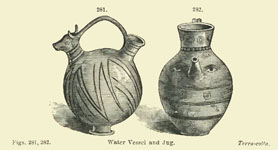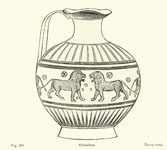Previous First Next
SALAMIS IN THE ISLAND OF CYPRUS.
BY ALEXANDER PALMA DI CESNOLÀ, F.S.A.,
page 118
 The two following vessels, found by me in the ground at Kurium, are of considerable interest, being of archaic insular style. The first (fig. 281) is evidently a water-bottle, not The two following vessels, found by me in the ground at Kurium, are of considerable interest, being of archaic insular style. The first (fig. 281) is evidently a water-bottle, not
1 L.c, cix, ex. unlike the Moorish water-coolers, made of red clay, in Spain, Portugal, and some parts of the northern littoral of Africa to this day. The head of the ox, which adorns the spout, and the acute-angled lines which embellish the surface, are, however, peculiar to this example. The other (fig. 282) is a pitcher, or jug, of an  archaic style, having two eyes, with a spout between them for sprinkling libations, or feeding purposes. It is also enrichedwith a number of sets of concentric circles. At Kurium, I found an interesting specimen of the oinochoe of transitional archaic Greek style, painted with lions face to face (fig. 283). It may be compared, for its shape and style, with an oinochoe adorned with animals and flowers figured in Dr. Birch's History of Ancient Pottery.1 The custom of adding small ornaments like those above, as well as fylfots, chequers, spirals, and so forth, is "commented upon by this authority in the same part of the work mentioned. archaic style, having two eyes, with a spout between them for sprinkling libations, or feeding purposes. It is also enrichedwith a number of sets of concentric circles. At Kurium, I found an interesting specimen of the oinochoe of transitional archaic Greek style, painted with lions face to face (fig. 283). It may be compared, for its shape and style, with an oinochoe adorned with animals and flowers figured in Dr. Birch's History of Ancient Pottery.1 The custom of adding small ornaments like those above, as well as fylfots, chequers, spirals, and so forth, is "commented upon by this authority in the same part of the work mentioned.
1 New Edition, p. 185.
Among the homely curiosities of this collection of terracotta utensils are several which deserve particular mention. I do not now allude to the numerous stately and beautiful vases, of many sizes and divers fashions in decoration, with which this collection is unusually enriched, nor even to those examples of the same use which are doubtless of greater antiquity, as well as less charmingly decorated than the latter. I allude to the group of fumigatore, incense-burners, or foot-warmers of terra-cotta now before us.1 I have called them fumigatore, because they were evidently intended to contain charcoal, or peat, and emit the fumes by means of the holes with which the sides of the vessels are furnished. They were, I think, really designed as foot-warmers, and intended for winter use in Cyprus by a luxurious people. The Dutch, and other northern nations, still employ analogous utensils. The ladies of Holland are accustomed to sit with such articles, when made of brass or copper, under their petticoats. The like, also, are not unknown in Venice. Most of them are furnished with handles arching over the tops, so that they may readily be taken from place to place even when ignited. Being from nine to fifteen inches high in the body, exclusive of the foot and overarching handle, one of these utensils Avould contain sufficient fuel to supply heat for a considerable number of hours, if it was allowed to stand still. They could not have been designed for incense-burners, being on too large a scale for that purpose, although they might have served as fumigatore. It is much more likely that they were foot-warmers. Two shallow bowls, perforated with triangular holes, and marked with chevron patterns, were obviously intended for use as strainers. Not more than half a dozen rhytons have been found in this collection. They are not large, nor rich in ornamentation. They appear to be of Roman origin. As to the amphorae, jars, jugs, ewers, and bottles proper, apart from bowls, paterǽ, and such like flat vessels, the number before us is very considerable indeed. They are of all 1 See Plate xx, figs. 18, 20. sizes, and, I doubt not, within the chronology of the ancient world, of nearly all dates. It seems probable that the greater portion are of native manufacture. Cyprus still supplies clay for the potter in the neighbourhood of Famagosta. I consider these works to be mostly of native manufacture, notwithstanding the well-known practice of the ancients to export pots to all parts of the world then known to them. I recollect that even in the remote Britain, countless specimens of Samian ware have been found, as well as examples of the craft of the indigenous potters. The repeated discovery of numerous pieces of foreign earthenware near the foot of the cliff at the mouth of the Thames, where now stand the Reculvers, is
Previous First Next
|